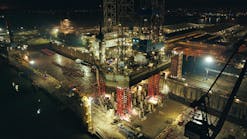A collection of factors has driven up the projected gas consumption of Florida. Current natural gas capacity for Florida is about 1.5 bcf/d. This usage volume is projected to double by 2007. This rapid growth in demand is spurring a flurry of proposed pipelines that would take Alabama gas across the Gulf.
In terms of population, Florida is one of the fastest growing states in the US, driving up demands for electrical power. Adding to the demand growth, coal-fired plants are under pressure to convert to cleaner burning natural gas and newbuild power generators are strongly encouraged to use gas as a fuel. The incentive is two fold; natural gas burns cleaner and, in the long run, is cheaper than coal because of the environmental savings.
In order to comply with the Federal Clean Air Act, Florida has to get serious about reducing the emission of hydrocarbons. One way to put a big dent in this effluent production is to convert power plants from coal to gas. The Williams Company reports such a conversion would save millions of tons of sulfur dioxide, carbon monoxide, and fine particulate matter.
Current natural gas demands
in Florida total about 1.5 bcf/d. Projections by the Florida Reliability Council identify a need to expand the power generation capacity of the state by 10,000 megawatts by 2007. If the source of all this power were gas, it would require an additional 1.5bcf/d, effectively doubling the state's demand.
Options
The increase in demand has prompt ed two new natural gas transportation lines to carry gas from Mobil Bay in Alabama, across the Eastern Gulf of Mexico and on to Southern Florida.
Currently, the only natural gas company operating in Florida is Florida Gas Transmission Company (FGT). FGT, which is an affiliate of Enron and Sonat, has just proposed a Phase IV expansion of its capacity and recently held an open season for Phase V that would include expansions aimed at satisfying this increased demand without a new pipeline offshore.
Williams has applied to the Federal Energy Regulatory Commission (FERC) to build a 36-in. pipeline that would cover the 400 miles from Mobil to the west coast of Florida, landing north of Tampa. Onshore, the pipeline would travel another 250 miles.
Williams proposed Buccaneer pipeline wold carry gas from Mobile Bay to Florida's West Coast.
The Coastal Corporation is developing the Gulfstream Natural Gas System (GNGS) transport pipeline along a similar offshore route as Buccaneer. Coastal is currently conducting open houses to get public input on its proposed land route before filing a pipeline certificate application with the FERC. Joe Martucci, a spokesman for GNGS, said the proposed onshore corridor began as a 10-mile wide swath and has now been narrowed to three-miles based on the company's review of topography, environmental features, market conditions, and opportunities for collocating with existing corridors. Coastal hopes these public meetings will allow it to narrow this corridor to 125 ft by early fall when the company will file with the FERC.
Environmental concerns aside, Martucci said Coastal has received the necessary market support to proceed with the pipeline. As with the Buccaneer, Gulfstream will originate in Mobile Bay, travel for 400 miles across the Eastern Gulf of Mexico. Buccaneer will connect with the coast north of Tampa, Florida. Gulfstream will make landfall south of Tampa, then proceed onshore for about 300 miles for a total length of 700 miles.
The FERC filing is anticipated around late summer. Martucci said the diameter of the offshore pipeline would be determined by the ultimate customer support.
Public interest, safety
FERC will evaluates these proposals under two major criteria, public interest and environmental safety. The first criterion, public interest, is basically an evaluation of demand. The FERC looks at a proposal and at the customers a company has lined up to buy the gas being transported and determines if the project is needed. Chris Stockton of Williams said his company believes that only one of these pipelines will actually be built because either could satisfy the increased demand. "Without the market support, none of these pipelines will be built," he said.
FERC will issue what is called a preliminary determination (PD) on non-environmental issues before it considers the environmental question. This PD will be the litmus test of the proposed projects, as it will show who has the customers necessary to demonstrate a public need for the pipeline. Once this determination is made, then an environmental impact statement is conducted to determine if the route of the line will harm the environment. While the environmental impact statement will no doubt be a long and involved process, it is the PD that will give the first indication of which pipeline will actually be built, according to Stockton. He said Williams has lined up a total
of 14 destination facilities for the Buccaneer pipeline. This includes some power plants that are converting to natural gas and some that are newbuilds.
Martucci said most of the letters of intent Coastal has received so far have come from local utilities and power producers engaged in new incremental growth for the state's electric power generation needs. While Williams is skeptical about the market for more than one transport line to Florida, Martucci said with the current and projected rate of growth in Florida's power consumption, Coastal believes there could eventually be enough demand to support two pipelines.
According to Gina Taylor with FGT, neither of the pipelines may be needed. She said the recent open season for the company's Phase V proposed expansion could satisfy all of this increased demand through increased compression in existing lines, including an onshore line the company owns that skirts the Gulf coast from South Texas to South Florida. By increasing compression, Taylor said FGT could accommodate Florida's growing natural gas needs with minimal new pipeline construction. If true, this would eliminate the need for any new transmission line offshore.




